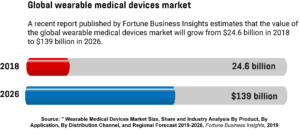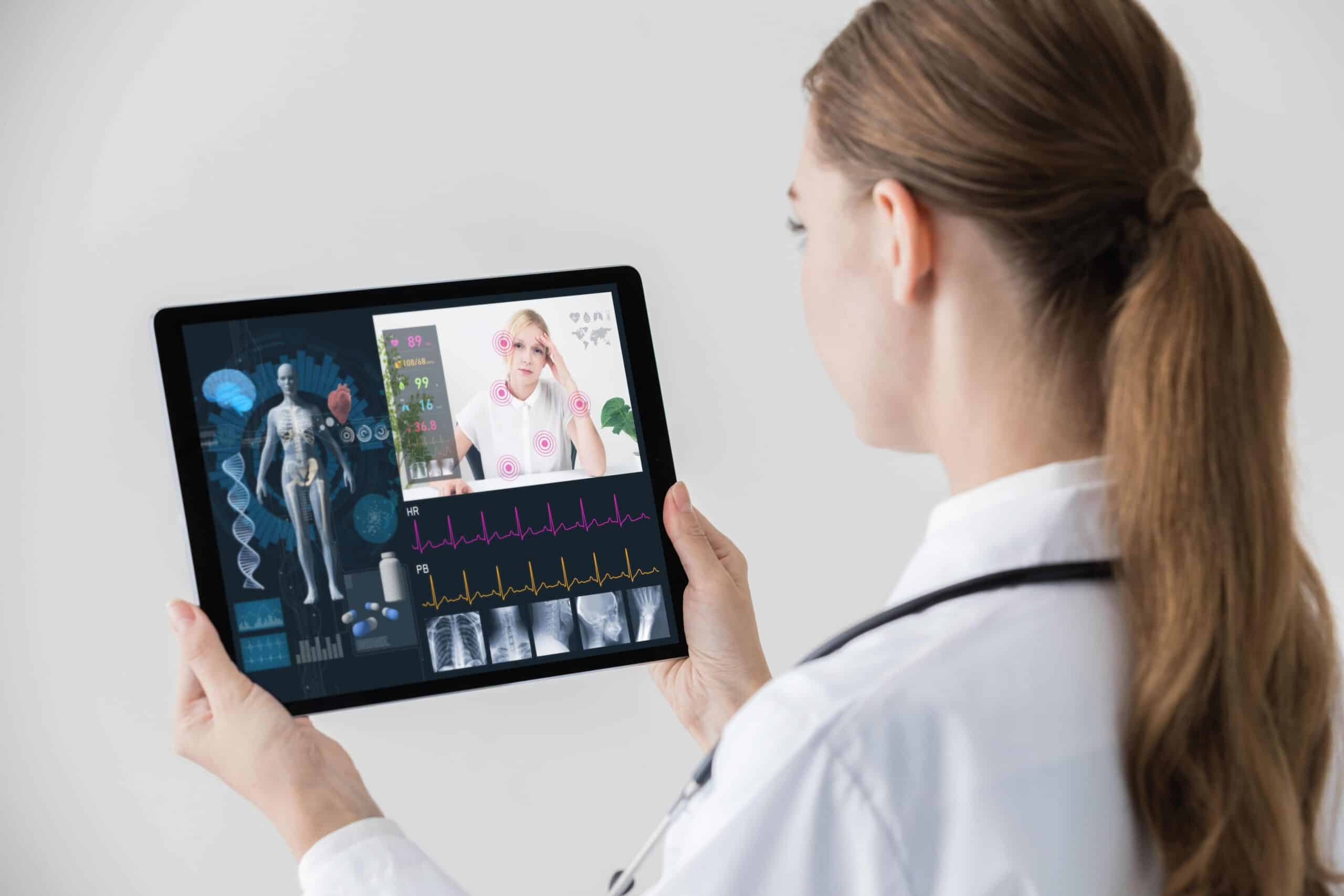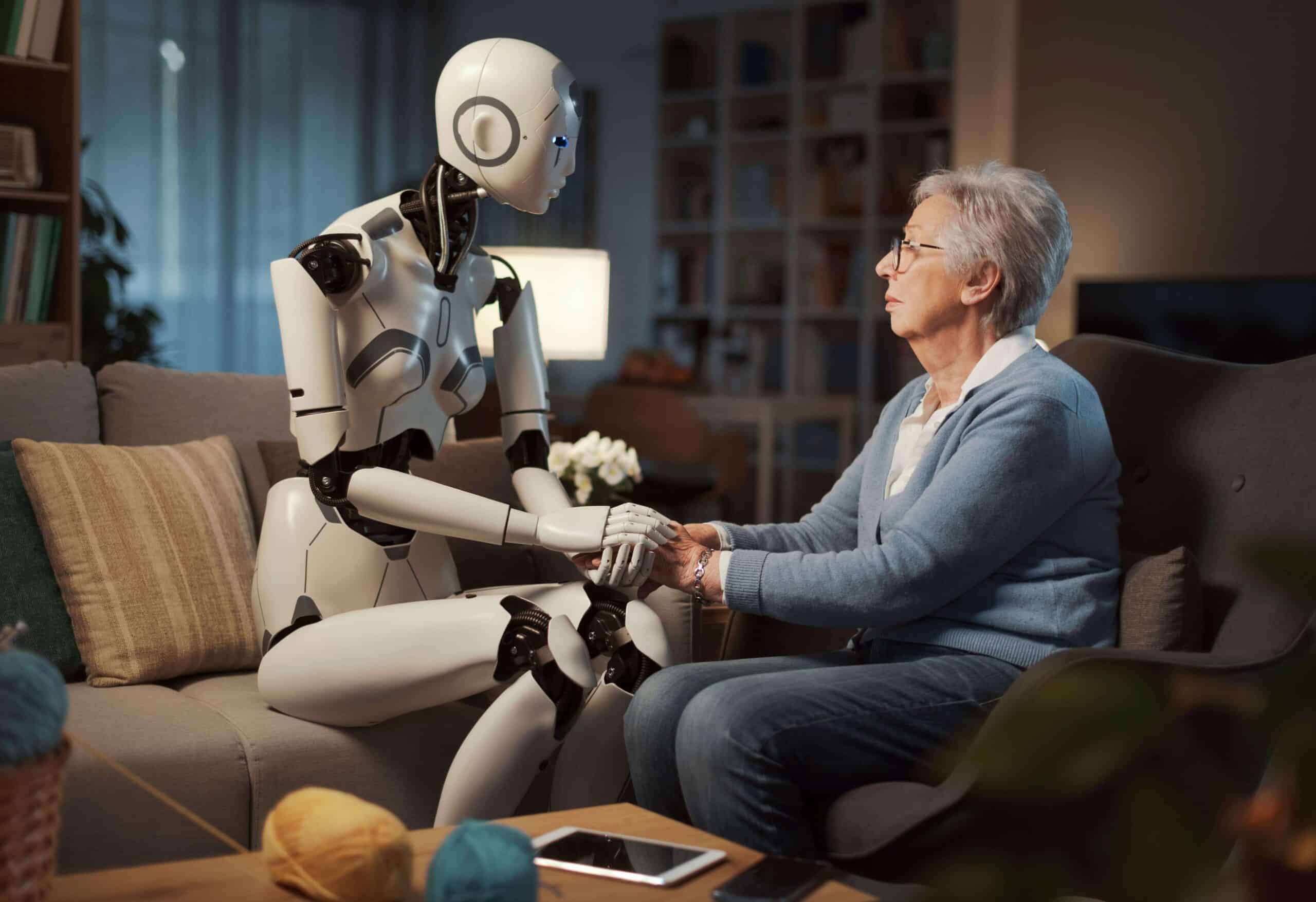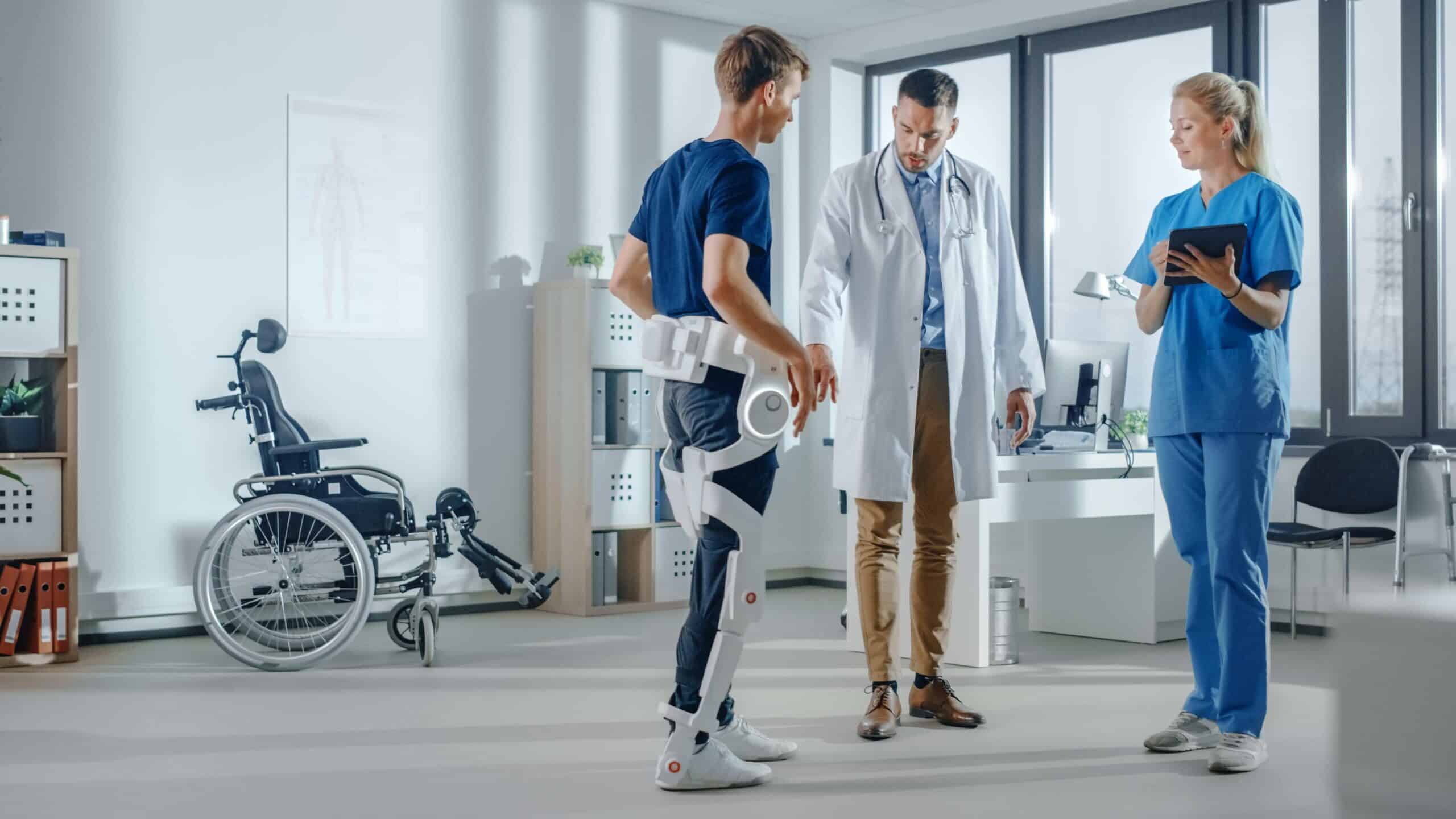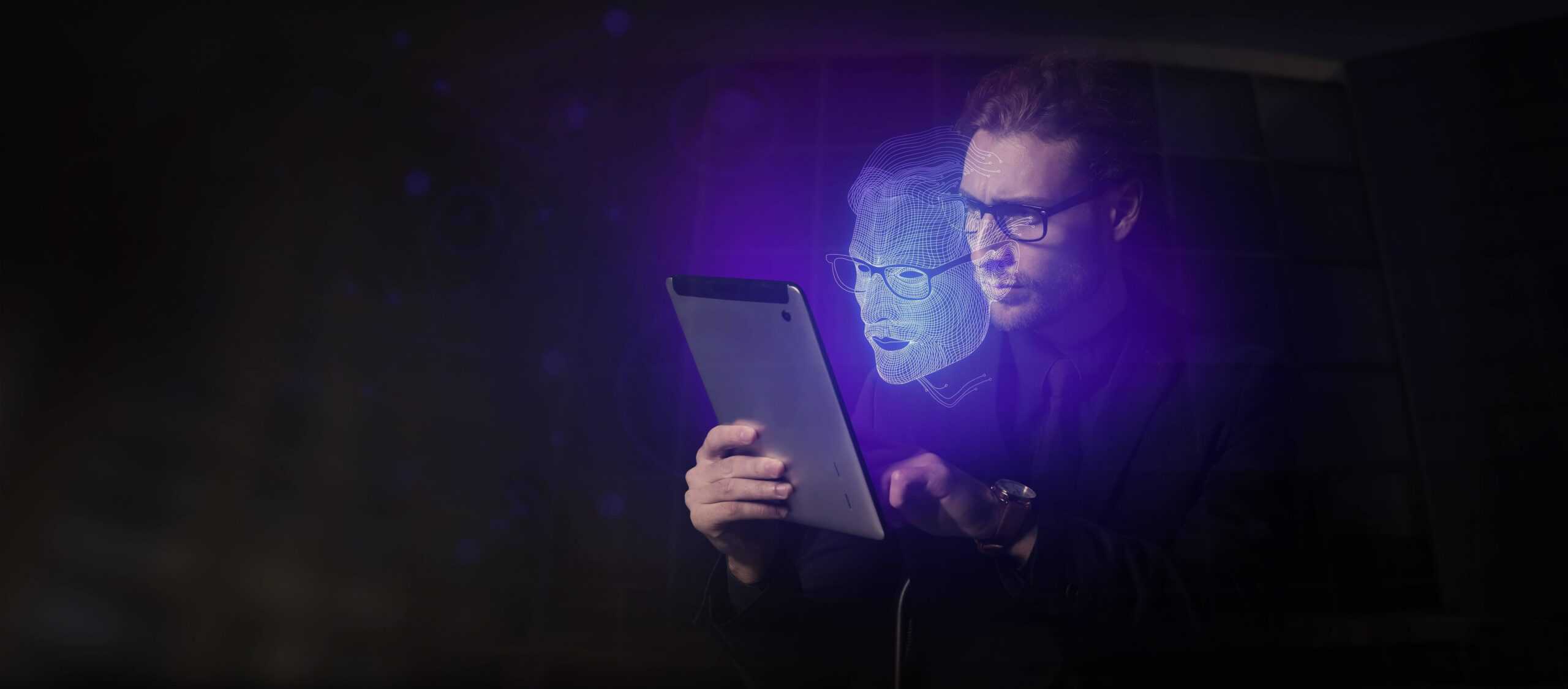- Biosensors and smart insoles help people diagnosed with diabetes
- Sensors measure health through sweat
- Yono Labs developed an in-ear ovulation predictor
- Advanced sensors detect a range of biochemical compounds
- A thin sheet provides patients with an artificial throat
- Current Health’s armband is an FDA-approved health monitoring device
- Omron launched a blood pressure monitoring smartwatch
- Myant embedded sensors into clothing products
- A powerful sensor placed on the hollow of a person’s throat
- Advanced technologies shape the future of medicine
The world population keeps on growing. By 2050, we’ll have 9.7 billion people on our planet – all of which will be living longer lives, thanks to advanced medical treatments, improved nutrition and cleaner living conditions.
These positive trends, however, have led to some new challenges. Healthcare systems around the world have to deal with a growing number of patients, many of whom require constant care as they suffer from strokes, diabetes, and other chronic illnesses. Doctors and nurses are overworked and in short supply. One way out of this impasse is monitoring patients remotely and dealing with their health problems preemptively. But turning these plans into reality requires finding a way to track medical data in real time.
Fortunately, technology offers a solution. Smart electronic devices, worn on the body or incorporated into clothing, are growing in popularity, and they can track heart rate, blood pressure, stress, glucose levels, and many other health-related data points. These wearables make it possible to deliver personalised medical care, reduce hospital readmissions, and prevent avoidable deaths. This reduces pressure on doctors and the healthcare system, which is why the global market for wearable medical devices is forecasted to reach $139 billion by 2026. And due to the efforts of entrepreneurs and scientists, people can choose from a variety of wearables in all shapes and sizes.
Biosensors and smart insoles help people diagnosed with diabetes
One of these products is a 3D-printed glucose biosensor developed by American researchers at the Washington State University. The device enables diabetes patients to monitor the disease in a non-invasive way and avoid finger pricking. Unlike traditionally manufactured sensors, this one contains no harmful chemicals and is more sensitive in detecting glucose signals. Also, it produces less waste during manufacturing. The next step is for the team to develop a wearable platform and electronic components that can carry the printed biosensor and turn it into a commercially viable product. Once on the market, the product should sell well, as “3D printing can enable manufacturing of biosensors tailored specifically to individual patients,” says Arda Gozen, an assistant professor at the university.
Apart from painful glucose monitoring procedures, people diagnosed with diabetes also have to live with the prospect of developing foot ulcers. These wounds, called diabetic feet, can sometimes lead to amputation, motivating an American scientist-turned-entrepreneur, Linh Le, to develop a smart insole. Manufactured and sold by his New York-based company, Bonbouton, the product is worn inside a regular pair of shoes and uses sensors to track changes in pressure and skin temperature. By analysing this data, the insole can determine if localised inflammation is about to occur and then notifies the user via a smartphone app. The program can also suggest the best course of action and can alert doctors or family members about the problems it discovers.
Sensors measure health through sweat
Scientists from Northwestern University in Chicago went one step further and developed a battery-free wearable sensor. The device is placed on the surface of the skin and captures information on sweat loss and sweat rate as well as electrolyte, glucose, and lactate levels. These data points indicate “physiological health, electrolyte balance, and hydration state,” says professor John Rogers, a physical chemist and materials scientist at the university. It can also help in cystic fibrosis diagnosis and rehabilitation tracking among stroke survivors.
The sensor consists of collection chambers, each of which measures a different parameter, and is powered by radio waves emitted from connected devices.
A team of researchers from Stanford University is working on something similar. They’ve found a non-invasive way to measure the levels of cortisol, a hormone that spikes when a person is stressed and leads to an increase in heart rate and blood pressure, through sweat. Detecting this hormone typically requires spending hours analysing blood samples, but they developed a sweat-sensing skin sensor that does the same task almost instantaneously. The device detects cortisol levels in seconds, helping scientists measure an array of conditions, such as emotional stress or metabolism and immune function. The next step is to improve the reliability of the instrument. Also, the team plans to develop a wearable device that could host the sensor and be used in real-world conditions.
Yono Labs developed an in-ear ovulation predictor
Sensors can also help women identify their fertility window. Currently, the detection of ovulation is done in several ways, including through blood progesterone levels, ultrasound, endometrial biopsy, ovulation predictor test, and by measuring basal body temperature (BBT). Although the last two methods are the most commonly used, they’re far from perfect. Getting an accurate picture of BBT is difficult, as the temperature needs to be measured every morning at the same time using skin-contact thermometers. Users then have to analyse the data themselves. That’s why Vanessa Xi founded Yono Labs, a Silicon Valley-based startup, and invented the world’s first in-ear ovulation predictor.
The product consists of two parts. The Yono, a small sensor, is placed inside the ear and takes 70 to 120 temperature readings throughout the night. The second part is the base station that transfers the collected data to the Yono smartphone app, which uses smart algorithms to monitor fertility, record the menstruation cycle, and predict ovulation. Furthermore, the company is cooperating with Peter Song, a professor of biostatistics at the University of Michigan, to improve the accuracy of its predictions. His algorithms filter irrelevant readings, such as “data below 32° C, because that’s not biologically possible”, says Song.
Advanced sensors detect a range of biochemical compounds
Scientists at the KTH Royal Institute of Technology in Sweden are working on multi-purpose electrochemical sensors that analyse blood and sweat. These devices can be woven into clothes, embedded into skin-patches, or inserted as microneedles. The key benefit of this tech is the broad range of biochemical compounds it measures, including sodium, chloride, calcium, magnesium, ammonium, glucose, uric acid, and glycine. The sensor even detects an increase in lactic acid during workouts. These capabilities ensure that these sensors “can be used in medical contexts at home or during athletic activity. They could also be tools in hospitals and clinics,” says Gaston Crespo, an associate professor at KTH.
Patients with kidney diseases, for instance, could benefit from having their electrolyte balance and hydration levels measured. Also, the sensor can detect potassium ions and creatinine levels in blood and is even able to “measure how stressed a person is, and their attentiveness”, explains Crespo. The device can be integrated with accelerometers and other existing sensors, providing users with a range of information on vital body functions.
A thin sheet provides patients with an artificial throat
Chinese researchers are working on a different type of wearable device. They’re developing an artificial throat that might help mute people speak even if their vocal cords are injured. The device consists of a thin sheet of polyvinyl alcohol film placed on a person’s throat, which is then connected to an armband that contains a decoder, a microcomputer, a circuit board, and a power amplifier. The results of the initial tests are encouraging. The instrument was able to convert noiselessly imitated throat motions of speech into sounds like the words “OK” and “No”. Although this technology isn’t yet a market-ready product, the researchers hope that customers will eventually be able to purchase the device and regain the ability to speak.
Current Health’s armband is an FDA-approved health monitoring device
Healthcare systems around the world are under pressure to deliver services to a growing number of patients. One way to do that without sacrificing the service quality is by shifting “more health care out of the hospital and into the community”, says Christopher McCann, the CEO of the US-based medical device company Current Health. The ability to measure patients’ health is crucial to these efforts. That’s why McCann and his team developed an armband that tracks a patient’s mobility, temperature, oxygen saturation, respiration, and pulse. The medical wearable has received clearance from the US Food and Drug Administration (FDA) for use at home and in the hospital.
Current Health’s device is most often used by patients suffering from chronic diseases, such as chronic obstructive pulmonary disease (COPD) and heart failure. These patients have high rates of hospitalisation, and monitoring their health in real-time helps doctors act preemptively and save lives. The collected medical data is integrated into electronic health records and is also used by Current Health to refine its algorithms and detect early warning signs in patients. And although the platform promotes at-home healthcare services, patients and doctors can still communicate through text messages and video calls.
Omron launched a blood pressure monitoring smartwatch
Another wearable with FDA clearance is HeartGuide, a smartwatch equipped with a blood pressure monitor. Produced by the Japanese electronics firm Omron, the device looks like any other smartwatch and measures hours slept, calories burned, steps walked, and distance covered. But what sets it apart from the competition is an expanding band that acts as a blood pressure cuff and inflates to take readings. The data is then relayed to an iPhone or Android app. Users can set the device to take measurements at regular intervals or trigger them manually.
Omron’s HeartGuide provides healthcare professionals with invaluable assistance. Instead of relying solely on patients’ blood pressure tests taken during hospital visits, doctors can now analyse measurements taken during several weeks or months. This helps them detect critical patterns and prevent patients from suffering a heart attack, kidney disease, and a range of other problems. And with around 1.13 billion people worldwide battling high blood pressure, Omron is tapping into a vast market. The only obstacle for reaching more customers might be the price, as HeartGuide costs $500, a significant sum for many people.
Myant embedded sensors into clothing products
Myant is another business with innovative health-monitoring solutions. Based in Canada, the textile company is developing undergarments embedded with four sensors that track the wearer’s sleep, posture, movement, breathing rate, temperature, and heart rate. The Skiin smartphone app then analyses the data, providing users with suggestions on how to improve their wellbeing. They can also share health information with doctors, friends, and family members. And customers are unlikely to feel or notice the presence of sensors. Brian Fung, Myant’s marketing strategist, says that “At the end of the day, you’re not going to feel like you are wearing technology. You’re going to feel like you’re wearing clothes.”
The company plans to produce more than just the underwear. From bras to shirts to sleep masks, customers will be offered an ever-growing variety of clothing products. Also, they’ll be able to subscribe to services such as arrhythmia detection, fall detection, and driver fatigue monitoring. Engineers are even developing a pregnancy band that could detect the heart rates and other vital signs of both mother and baby. A newborn’s crib sheet might eventually be turned into a sensors-rich environment, helping hospitals provide better care.
A powerful sensor placed on the hollow of a person’s throat
Scientists led by Dr John Rogers at Northwestern University are working on one of the most ambitious medical wearables. The team is developing a smart patch that’s embedded in a flexible silicone gel and placed on the hollow of a person’s throat. Thanks to the advanced technology and unconventional placement, the sensor can track almost any bodily function that involves mechanical movement of tissue and organs, including body orientation, breathing, sleep, swallowing, heart rhythm, vocal vibrations, snoring, and coughing. The device can also pinpoint each time the wearer talks or swallows during a meal.
There are many benefits to collecting health data. Doctors can make more accurate diagnoses, while real-time monitoring of breathing can tell them whether an anxiety-prone patient is going through a panic attack. Voice analysis could even suggest if patients are developing mental health disorders. The benefits are endless, but protecting sensitive medical data remains an equally important task. Tech firms, insurers, and even governments could harness health-related information for various purposes, which is why countries should adopt data privacy laws that regulate this matter.
Advanced technologies shape the future of medicine
The healthcare of tomorrow will increasingly move into the patient’s home as health systems try to reduce pressure on hospitals. The critical part of these endeavours is using wearables to measure patient data remotely, allowing doctors to detect and solve medical problems before they escalate. Fortunately, healthcare professionals can choose from an array of sophisticated medical devices that track blood pressure, breathing, heart rate, hormones, and various other data points. And as the demand for these products increases, scientists and entrepreneurs are poised to come up with ever more sophisticated technologies and sensors.

